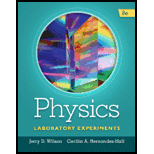
Concept explainers
Scientists use models and theories to describe physical phenomena. When a new model is developed, it must be tested to find out if it is an accurate representation. No theory or model of nature is valid unless its predictions are in agreement with experimental results. The laboratory provides an environment where extraneous factors can be minimized and specific predictions can be tested. The process of making, testing, and refining models is usually called the scientific method (see Experiment 1).
An example of this method will be demonstrated in this experiment for a simple pendulum. A “simple” pendulum is one in which a small but substantial mass is suspended on a relatively light string, like the one pictured in Fig. 4.1. If one were to observe the motion of the mass swinging back and forth, which of the following statements do you think would be the most accurate? (It is understood that the motion takes place in a single plane.)
The time for the mass to swing back and forth (from point A to B, and back to A in Fig. 4.1.)
- (a) changes randomly from one swing to the next.
- (b) gets consistently bigger from one swing to the next.
- (c) gets consistently smaller from one swing to the next.
- (d) stays about the same from one swing to the next.
(Circle your choice)
The most accurate statement regarding the motion of a simple pendulum.
Answer to Problem 1EP
Option (d) The time for the mass to swing back and forth stays about the same from one swing to the next.
Explanation of Solution
The time for the mass of the simple pendulum to swing back and forth is termed as the period of oscillation. The period of oscillation of the pendulum depends only on the length of the pendulum and it can be obtained from the relation,
T=2π√Lg
Here, T is the period, L is the length of the pendulum, and g is the acceleration due to gravity.
For a pendulum of fixed length, the period of oscillation remains the same for all oscillations, unless the pendulum is subjected to considerable friction or air resistance.
Conclusion:
Since the time for the mass of the pendulum to swing back and forth stays about the same from one swing to the next, option (d) is correct.
The period of the simple pendulum does not change randomly from one swing to the next. Thus, option (a) is incorrect.
The period of the simple pendulum does not get consistently bigger from one swing to the next. Thus, option (b) is incorrect.
The period of the simple pendulum does not get consistently smaller from one swing to the next. Thus, option (c) is incorrect.
Want to see more full solutions like this?
Chapter 4 Solutions
Physics Laboratory Experiments
- A man slides two boxes up a slope. The two boxes A and B have a mass of 75 kg and 50 kg, respectively. (a) Draw the free body diagram (FBD) of the two crates. (b) Determine the tension in the cable that the man must exert to cause imminent movement from rest of the two boxes. Static friction coefficient USA = 0.25 HSB = 0.35 Kinetic friction coefficient HkA = 0.20 HkB = 0.25 M₁ = 75 kg MB = 50 kg P 35° Figure 3 B 200arrow_forwardA golf ball is struck with a velocity of 20 m/s at point A as shown below (Figure 4). (a) Determine the distance "d" and the time of flight from A to B; (b) Determine the magnitude and the direction of the speed at which the ball strikes the ground at B. 10° V₁ = 20m/s 35º Figure 4 d Barrow_forwardThe rectangular loop of wire shown in the figure (Figure 1) has a mass of 0.18 g per centimeter of length and is pivoted about side ab on a frictionless axis. The current in the wire is 8.5 A in the direction shown. Find the magnitude of the magnetic field parallel to the y-axis that will cause the loop to swing up until its plane makes an angle of 30.0 ∘ with the yz-plane. Find the direction of the magnetic field parallel to the y-axis that will cause the loop to swing up until its plane makes an angle of 30.0 ∘ with the yz-plane.arrow_forward
- A particle with a charge of − 5.20 nC is moving in a uniform magnetic field of (B→=−( 1.22 T )k^. The magnetic force on the particle is measured to be (F→=−( 3.50×10−7 N )i^+( 7.60×10−7 N )j^. Calculate the y and z component of the velocity of the particle.arrow_forwardneed answer asap please thank youarrow_forward3. a. Determine the potential difference between points A and B. b. Why does point A have a higher potential energy? Q = +1.0 C 3.2 cm 4.8 cm Aarrow_forward
 Principles of Physics: A Calculus-Based TextPhysicsISBN:9781133104261Author:Raymond A. Serway, John W. JewettPublisher:Cengage Learning
Principles of Physics: A Calculus-Based TextPhysicsISBN:9781133104261Author:Raymond A. Serway, John W. JewettPublisher:Cengage Learning College PhysicsPhysicsISBN:9781938168000Author:Paul Peter Urone, Roger HinrichsPublisher:OpenStax College
College PhysicsPhysicsISBN:9781938168000Author:Paul Peter Urone, Roger HinrichsPublisher:OpenStax College Physics for Scientists and Engineers: Foundations...PhysicsISBN:9781133939146Author:Katz, Debora M.Publisher:Cengage Learning
Physics for Scientists and Engineers: Foundations...PhysicsISBN:9781133939146Author:Katz, Debora M.Publisher:Cengage Learning University Physics Volume 1PhysicsISBN:9781938168277Author:William Moebs, Samuel J. Ling, Jeff SannyPublisher:OpenStax - Rice University
University Physics Volume 1PhysicsISBN:9781938168277Author:William Moebs, Samuel J. Ling, Jeff SannyPublisher:OpenStax - Rice University Physics for Scientists and Engineers, Technology ...PhysicsISBN:9781305116399Author:Raymond A. Serway, John W. JewettPublisher:Cengage Learning
Physics for Scientists and Engineers, Technology ...PhysicsISBN:9781305116399Author:Raymond A. Serway, John W. JewettPublisher:Cengage Learning Glencoe Physics: Principles and Problems, Student...PhysicsISBN:9780078807213Author:Paul W. ZitzewitzPublisher:Glencoe/McGraw-Hill
Glencoe Physics: Principles and Problems, Student...PhysicsISBN:9780078807213Author:Paul W. ZitzewitzPublisher:Glencoe/McGraw-Hill





